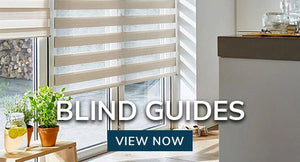Choosing window dressings based on location, style and shape
 The location, shape and style of windows you have in your home can greatly influence the window dressing you choose – from the type of window dressing right down to the colour and material. Use our expert guide to assessing windows and get your window treatment right every time. Take few minutes to assess the type and location of windows you have in your home before you make any decision on how to dress them with curtains, poles and tracks, and you'll be achieving designer style results in no time. Windows function as providers of light, as architectural detail and frames through which you view the outside world. They are important features in a room and you should take into account their various functions when choosing how to dress them. Therefore, before deciding on a style of curtains or blinds, first consider the shape and proportion of your window in relation to the rest of the room and whether its position in the room poses any limitations on the type of the window treatments you can use.
The location, shape and style of windows you have in your home can greatly influence the window dressing you choose – from the type of window dressing right down to the colour and material. Use our expert guide to assessing windows and get your window treatment right every time. Take few minutes to assess the type and location of windows you have in your home before you make any decision on how to dress them with curtains, poles and tracks, and you'll be achieving designer style results in no time. Windows function as providers of light, as architectural detail and frames through which you view the outside world. They are important features in a room and you should take into account their various functions when choosing how to dress them. Therefore, before deciding on a style of curtains or blinds, first consider the shape and proportion of your window in relation to the rest of the room and whether its position in the room poses any limitations on the type of the window treatments you can use.
 Pair of identical windows in same wall - These should be treated as one or in the same way. You could opt for two pairs of curtains, two blinds or one single curtain on each window, mirroring one another.
Pair of identical windows in same wall - These should be treated as one or in the same way. You could opt for two pairs of curtains, two blinds or one single curtain on each window, mirroring one another.
 Two different windows in same wall - Whether you use curtains or blinds, give smaller, lower height windows a heading at the same level as their larger neighbour. Consider the decorative impact when curtains are open and windows revealed, as well as when they are closed.
Two different windows in same wall - Whether you use curtains or blinds, give smaller, lower height windows a heading at the same level as their larger neighbour. Consider the decorative impact when curtains are open and windows revealed, as well as when they are closed.
 Two or more difference windows in the same room - In this situation it pays to choose different arrangements for the different window styles, but to stick to the same fabrics. If, for example, one pair of curtains has a contrast border, then use the same idea on a neighbouring blind. You can also link the two by using the same style poles or tiebacks.
Two or more difference windows in the same room - In this situation it pays to choose different arrangements for the different window styles, but to stick to the same fabrics. If, for example, one pair of curtains has a contrast border, then use the same idea on a neighbouring blind. You can also link the two by using the same style poles or tiebacks.
 Windows or sliding door taking up all or most of a wall - Here, you need to think carefully about where the curtains will hang when the window or door is open. Often there is little room to either side of the window, therefore avoid thick fabrics or heavily gathered headings that will cause the fabric to bulk.
Windows or sliding door taking up all or most of a wall - Here, you need to think carefully about where the curtains will hang when the window or door is open. Often there is little room to either side of the window, therefore avoid thick fabrics or heavily gathered headings that will cause the fabric to bulk.
 French windows - These lend themselves to a pair of curtains hanging down both sides. There may be some restrictions if the doors open inwards so position poles wisely. Keep curtaining simple and hold curtains off the windows with tiebacks to provide clear access.
French windows - These lend themselves to a pair of curtains hanging down both sides. There may be some restrictions if the doors open inwards so position poles wisely. Keep curtaining simple and hold curtains off the windows with tiebacks to provide clear access.
 Bay windows - The normal way to treat a bay window with a curved track concealed with some kind of pelmet or fascia. However, you could treat each window singly, with Roman or panel blinds, for example.
Bay windows - The normal way to treat a bay window with a curved track concealed with some kind of pelmet or fascia. However, you could treat each window singly, with Roman or panel blinds, for example.
 Single window in a wall - Here, you have almost carte blanche. Whichever style you choose, remain close to the proportions of the window. Instead of a pair of curtains, you could balance a single curtain with furniture or pictures or hang a blind.
Single window in a wall - Here, you have almost carte blanche. Whichever style you choose, remain close to the proportions of the window. Instead of a pair of curtains, you could balance a single curtain with furniture or pictures or hang a blind.
 Window close to an adjacent wall - This often results from a room being partitioned leaving a window off-centre. Emphasize this asymmetry and go for a single curtain with a strongly decorative heading and chunky tieback.
Window close to an adjacent wall - This often results from a room being partitioned leaving a window off-centre. Emphasize this asymmetry and go for a single curtain with a strongly decorative heading and chunky tieback.
 Window close to a ceiling - If there is no wall space for a support, you can use a ceiling fixing, or fix a fabric-covered board securely to the ceiling to spread the weight of a pole or track beneath it.
Window close to a ceiling - If there is no wall space for a support, you can use a ceiling fixing, or fix a fabric-covered board securely to the ceiling to spread the weight of a pole or track beneath it.
 Window in a deep recess - This requires simple window furnishings - slot-head curtains on slim poles or those that can swing out from their fixings. If light is important, avoid bulky fabrics that will block the window. Fix poles close to the window and into the frame.
Window in a deep recess - This requires simple window furnishings - slot-head curtains on slim poles or those that can swing out from their fixings. If light is important, avoid bulky fabrics that will block the window. Fix poles close to the window and into the frame.
 Window with radiator beneath - This problem is best treated with a simple design solution such as a sill-length curtain or blind. Or, ignore the radiator and go for floor-length curtains. Try, for example, a single curtain on a pole pulled back to one side and balanced with a chunky rope looped around the curtainless end of the pole.
Window with radiator beneath - This problem is best treated with a simple design solution such as a sill-length curtain or blind. Or, ignore the radiator and go for floor-length curtains. Try, for example, a single curtain on a pole pulled back to one side and balanced with a chunky rope looped around the curtainless end of the pole.
 Windows on stairs, where floor is uneven - Blinds are ideal for this situation, but you could consider a single curtain, embellished with wonderful tiebacks or ornate finials.
Windows on stairs, where floor is uneven - Blinds are ideal for this situation, but you could consider a single curtain, embellished with wonderful tiebacks or ornate finials.
Most windows fall into one of these categories: portrait (taller than wide), landscape (wider than high) or square. There can, of course, be multiples of these and in some cases, two or more portrait windows that are side by side in a wall may become a landscape shape. Portrait windows are the most common shape and the most versatile in terms of how they can be dressed. They are often set high in the wall and can extend to the floor as with French windows. Portrait windows can take a pair of curtains in any style, most forms of blind or a single curtain, perhaps extended to the floor to accentuate the shape and held with a tieback on one side.
Landscape windows range from large picture windows and sliding doors to side-by-side loft windows and small casements. Pairs of curtains in most styles suit this category. However, keep your headings relatively simple to avoid making the window appear squat and top heavy. Where windows are very wide, curtaining can be difficult as there is so much fabric to 'store' at each side. Consider blinds for a simpler, less cluttered feel.
Square windows can be tiny cottage windows, often recessed, or much larger windows that are often found in more contemporary homes. For the former you need a treatment that does not need much space around the window, while for the latter you need one that lets in the maximum light during the day.



























































